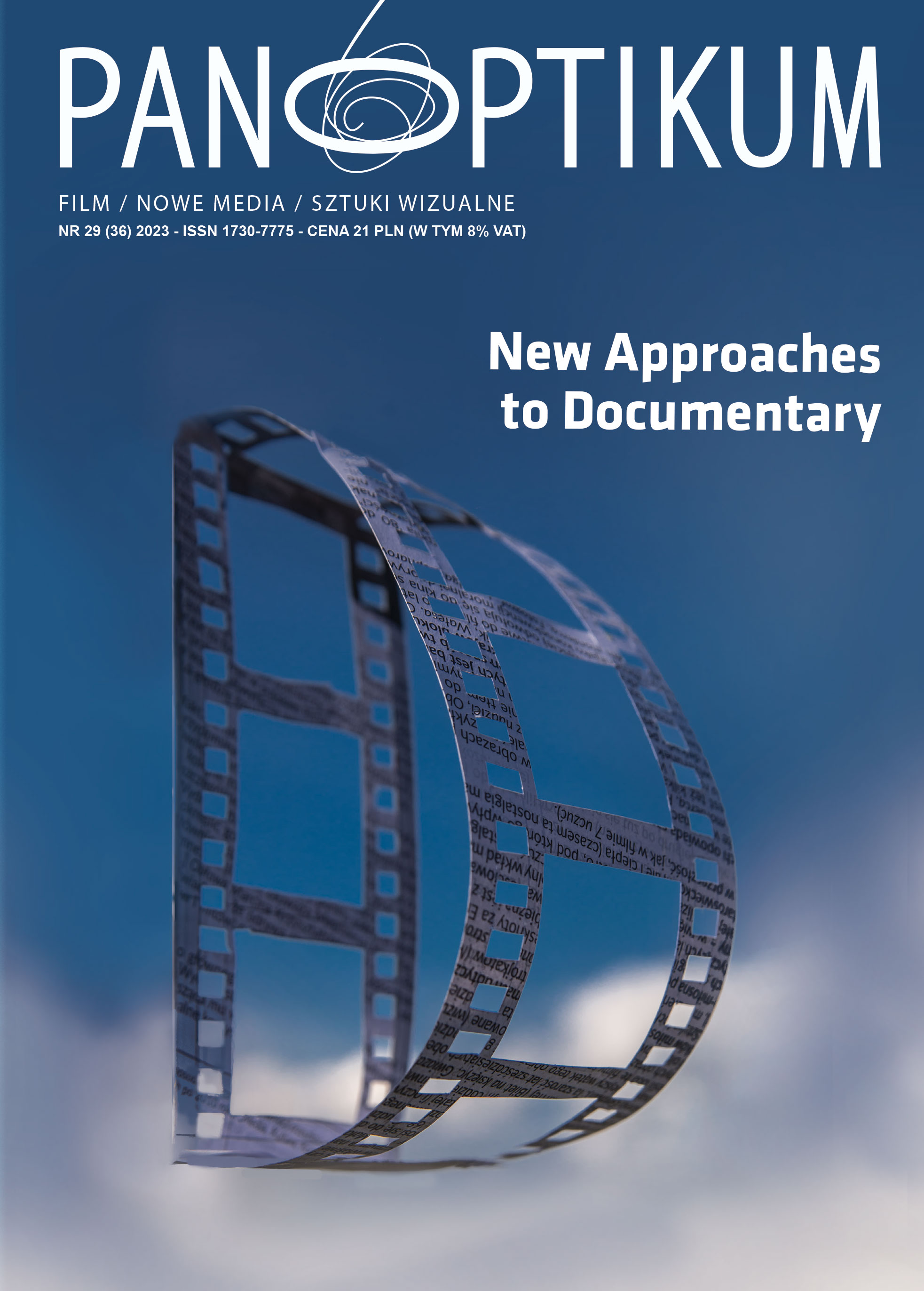A Defiant Act of Looking: Prisoners’ Illicit Documentary Practices of Shooting-Back
DOI:
https://doi.org/10.26881/pan.2023.29.07Słowa kluczowe:
digital technology, prison, amateur recordings, media practice, media witnessing, cellphone camera, state warfare, new media, frame, POVAbstrakt
During an armed security operation on Lebanon’s most notorious prison, an image emerges from the POV of a prisoner. Capturing the military vehicles and the prison bars obstructing his vision, a prisoner snatches a photograph through his illicitly smuggled cellphone camera.
In this article, I follow the events of Lebanese authorities’ intervention on Roumieh Central Prison’s Bloc B and collect a sample of images and videos produced and circulated by prisoners as the operation was taking place. By examining the frame, composition, POV, sound, and montage of such amateur fragmentary cellphone recordings, I note two major modes of framing adopted by prisoners; one frames outside the bars and the second frames inside. I contextualize such modes of framing as ‘counter-shots’ in relation to the state’s media strategies of legitimizing its repressive actions and I argue that prisoners utilize smuggled media technologies, such as the cellphone and its camera, as a response to the state’s performative acts of sovereignty. Prisoners operationalize the frame and the POV to create a ‘counter’ way of seeing and documenting the events on Bloc B. Hence, prison cellphone recordings reflect not only what is portrayed inside their frames, but also their means of production. Through the framework of media as practice and the notion of media witnessing, I argue that the illicitly produced modes of framing reflect a practice of media production based around the smuggling of media technologies into the prison. Through such a practice, prisoners produce images and videos to represent and document their lived experiences, relay testimonies, and make the audience bear witness to the horrific and precarious conditions of incarceration; hence, engaging in a practice of documentation from the prison.
Downloads
Bibliografia
Amel, M. (1986). Fi Al-Dawla Al-Ta’ifiyya [In the Sectarian State]. Beirut: Dar al-Farabi: Dar Al-Farabi.
Andén-Papadopoulos, K. (2014). Citizen camera-witnessing: Embodied political dissent in the age of ‘mediated mass self-communication’. New Media & Society 16(5): 753–769. DOI: 10.1177/1461444813489863.
Appadurai, A. (1996). Modernity at Large: Cultural Dimensions of Globalization. “Public worlds” v. 1. Minneapolis, Minn: University of Minnesota Press.
Butler, J. (2005). Photography, War, Outrage. PMLA/Publications of the Modern Language Association of America 120(3): 822–827. DOI: 10.1632/003081205X63886.
Chouliaraki, L. (2015). Digital witnessing in conflict zones: the politics of remediation. Information, Communication & Society 18(11): 1362–1377. DOI: 10.1080/1369118X.2015.1070890.
Didi-Huberman, G. (2012). Images in Spite of All: Four Photographs from Auschwitz. Chicago: University of Chicago Press.
El Hindi, D. (2013). Guilty until Proven Innocent - REPORT ON THE CAUSES OF ARBITRARY ARREST, LENGTHY PRE-TRIAL DETENTION AND LONG DELAYS IN TRIAL. January. Lebanon: ALEF- Act for Human Rights. Available at: https://alefliban.org/wp-content/uploads/2016/10/ALEF-Arbitrary-Detention-2013.pdf (accessed 15 November 2022).
Feldman, A. (1991). Formations of Violence: The Narrative of the Body and Political Terror in Northern Ireland. Chicago: University of Chicago Press.
Feldman, A. (2000). Violence and Vision: The Prosthetics and Aesthetics of Terror. Public Culture 10(1): 24–60. DOI: 10.1215/08992363-10-1-24.
Feldman, A. (2015). Archives of the Insensible: Of War, Photopolitics, and Dead Memory. Chicago: The University of Chicago Press.
Frosh, P. and Pinchevski, A. (eds) (2009). Media Witnessing. London: Palgrave Macmillan UK. DOI: 10.1057/9780230235762.
Lebow, A. (2012). Shooting with Intent: Framing Conflict. In: Ten Brink, J. and Oppenheimer, J. (eds) Killer Images: Documentary Film, Memory and the Performance of Violence. Nonfictions series. London ; New York : Wallflower Press ; Arts & Humanities Research Council.
Lons, C. (2016). Is justice for everyone? Arbitrary detention and torture of Islamists in Lebanon. Civil Society Knowledge Centre 1(1). DOI: 10.28943/CSKC.002.40001.
Mattoni, A. (2012). Media Practices and Protest Politics: How Precarious Workers Mobilise. Available at: https://www.taylorfrancis.com/books/e/9781315594521 (accessed 11 May 2022).
Mattoni, A. and Treré, E. (2014). Media Practices, Mediation Processes, and Mediatization in the Study of Social Movements. Communication Theory 24(3): 252–271. DOI: 10.1111/ comt.12038.
Najem, CT. (2016). Can the Prisoner Speak?: An Ideological and Visual Analysis of Prisons in Lebanese Television News. Thesis. M.A. American University of Beirut. Department of Sociology, Anthropology and Media Studies, Beirut. Available at: http://hdl.handle.net/10938/11027.
Najem, CT. (2023). Calls from Beyond the Walls: prison cellphone recordings during the pandemic in Lebanon. Media, Culture & Society: 016344372211468. DOI: 10.1177/01634437221146889.
Rabinbach, A. (1992) The Human Motor: Energy, Fatigue, and the Origins of Modernity. Berkeley: University of California Press.
Rushchenko, J. (2018). PRISON MANAGEMENT OF TERRORISM-RELATED OFFENDERS: IS SEPARATION EFFECTIVE? London: The Henry Jackson Society. Available at: https://henryjacksonsociety.org/wp-content/uploads/2018/03/HJS-PrisonManagement-Report.pdf.
Sontag, S. (2003). Regarding the Pain of Others. New York, N.Y: Picador.
Tagg, J. (2002). The Burden of Representation: Essays on Photographies and Histories. Transferred to digital print. Communication and culture. Basingstoke: Palgrave Macmillan.
Torchin, L. (2012). Creating the Witness: Documenting Genocide on Film, Video, and the Internet. University of Minnesota Press. DOI: 10.5749/minnesota/9780816676224.001.0001.
West, K. (2017). Visual Criminology and Lombroso: In Memory of Nicole Rafter (1939–2016). Theoretical Criminology 21(3): 271–287. DOI: 10.1177/1362480617692173.

 Uniwersyteckie Czasopisma Naukowe
Uniwersyteckie Czasopisma Naukowe









